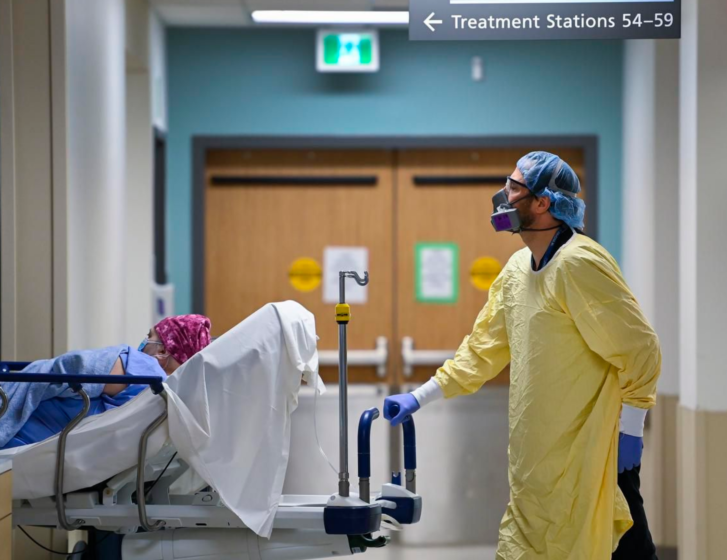With Omicron cases rapidly rising in Ontario and other provinces, public health experts and policy-makers are revising quarantine and isolation rules, due to newly emerging data on the variant and to avoid staffing shortages at hospitals.
On Wednesday, the Ontario government announced hospital workers who have been in close contact with someone who is COVID-positive don’t have to stay home and isolate, as long as they test negative daily for 10 days.

And earlier on Wednesday, the U.K. government announced the reduction of COVID-19 self-isolation periods from 10 to seven days for people who test negative through a rapid test two days in a row — a decision experts lauded as “significant.”
Ontario’s decision to revise isolation protocol for health-care workers comes after reports of a rising number of hospital staff who have recently tested positive for COVID-19, or have been exposed to the virus in the community, prompting worries about critical staffing shortages that could impact patient care.
Speaking to reporters on Tuesday, Dr. Kieran Moore, Ontario’s chief medical officer of health, said the province wants to have enough rapid tests for hospital staff exposed to the virus so they could test themselves every day instead of having to isolate for 10 days, as the current policy requires.
“We are partnering with our local public health agencies, are learning from their experience, and are anticipating a rise in cases where we’re going to have to provide more broad advice to the public, both on the testing strategy (and) the isolation strategy,” Moore said.
He added he anticipates a “20 to 30 per cent risk of absenteeism” due to COVID-19 exposure if asymptomatic hospital staff who are close contacts of COVID-positive patients have to stay home from work.
Alexandra Hilkene, spokesperson for Health Minister Christine Elliott, said the guidance now is to have hospital staff take a PCR test as soon as they’re exposed to COVID-19, and take another one seven days after. Meanwhile, they can continue working if they test negative every day through the self-administered rapid antigen tests and are asymptomatic.
For hospital workers living with someone who is COVID-positive, the lab-based PCR tests have to be taken immediately, as well as days seven and 14 or 15. They also have to take a rapid test daily and for 10 days afterwards.

Dr. John Granton, a critical care physician and interim medical director of Health Services at University Health Network in Toronto, said discussions have already been underway at UHN to revise rules for COVID-19 exposures, particularly for health-care workers who are now rapidly coming into contact with the virus, forcing them to stay home.
“We’re seeing a lot of staff who are testing positive, or more commonly have a community exposure,” Granton said, adding hospitals have been debating the balance of the theoretical risk of a COVID-19 exposure versus the risk of not being able to support clinical programs or the needs of patients.
He said for people with a sick family member living at home, the likelihood of testing positive is higher, as contact is more frequent and ventilation tends to be poor at home. But those who get exposed to COVID-19 through a limited encounter with a patient or a co-worker, especially in hospitals that are generally better ventilated, are less likely to get sick.
Prior to Ontario’s recent recommendation, staff exposed to the virus from home often have to isolate for at least 20 days (10 additional days after the quarantine period for the COVID-positive household member passes).
Other provinces have also expressed worry about having too many staff off work due to virus exposure. New Brunswick’s chief medical officer of health, Jennifer Russell, said her province is considering test-to-stay policies for hospital workers, while reports say Quebec is considering keeping asymptomatic COVID-positive nurses at work to care for patients who have also been exposed.
Quebec’s proposal has been met by pushback, however, from unions representing the province’s nurses, who said they are worried about exposing other essential workers to the virus by keeping asymptomatic staff at work.
For the general population, isolation periods could also be revised given the U.K.’s “significant” decision to change theirs, Granton said. He added the U.K.’s guidance is likely related to emerging data — including a study from Oslo, Norway — that shows the incubation period for Omicron may be shorter than other COVID-19 variants.
“If you haven’t become sick by day seven, it’s not likely you’re going to become sick,” Granton said. Previously, other variants’ incubation period — the time it takes from exposure to become sick — was up to a week. But new research shows illness from Omicron could develop three days or less after exposure.
Early evidence from other countries also shows Omicron has no significant impact on child hospitalizations, which Moore, Ontario’s chief medical officer of health, said is promising. He added he doesn’t see a reason to delay the return to school after the December holidays.
Data is still emerging about the Omicron variant, Moore said, and the situation could change in the coming weeks. Ontario reported 4,383 new cases of COVID-19 on Wednesday, a 132.5 per cent increase from last week’s average, and cases are expected to rise.
Article From: The Star
Author: Nadine Yousif

